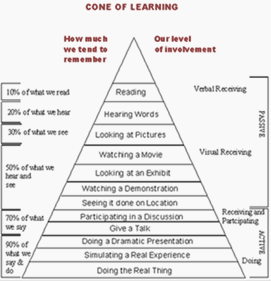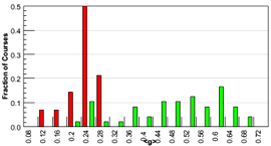|
Why don't we teach the way students learn?
Eighty-nine percent of U.S. professors lecture as a mode of instruction. However, the literature shows that students must do more than just listen to truly learn.
Active Learning (Bonwell and Eison) When using active learning students are engaged in more activities than just listening. They are involved in dialog, debate, writing, and problem solving, as well as higher-order thinking, e.g., analysis, synthesis, evaluation.
Cooperative Learning (Johnson, Johnson, and Smith) Cooperative learning is the instructional use of small groups so that students work together to maximize their own and each others learning.
Five essential components must be present for small-group learning to be truly cooperative:
- clear positive interdependence between students
- face to face interaction
- individual accountability
- emphasize interpersonal and small-group skills
- rocesses must be in place for group review to improve effectiveness
Why should we care?
"
cooperative learning produces higher achievement, more positive relationships among students, and healthier psychological adjustment than do competitive or individualistic experiences."
"
active/cooperative methods can increase mechanics course effectiveness well beyond that obtained in traditional practice."
"
various forms of small-group learning are effective in promoting greater academic achievement, more favorable attitudes toward learning, and increased persistence in SMET [science, engineering, mathematics, technology] courses and programs."

How can I get started?
Active Learning
You can incorporate active learning into your classroom in several ways, including modification of existing lectures, in-class discussions, case studies and guided designs.
Cooperative Learning
Try a cooperative learning structure called Think-Pair-Share in which you pose a question, ask students to think about it, ask students to discuss their answers in pairs, and then call on students to share their answers with the class.
What does research indicate?
Example One
This paper compares outcomes for an experimental group to those for students in a traditionally-taught comparison group. The experimental group outperformed the comparison group on a number of measures. The pedagogy should be adaptable to any engineering curriculum at any institution since large classes were used and special classrooms were not required.
Example Two
Analysis of multiple research studies demonstrates that various forms of small-group learning are quite effective in promoting greater academic achievement, more favorable attitudes toward learning, and increased persistence in SMET courses and programs. The analysis supports more widespread implementation of small-group learning in undergraduate SMET courses.
Example Three
The graph below shows the fraction of courses achieving a specific normalized gain on the Force Concept Inventory. Courses using traditional lectures are shown in red (dark), while courses using interactive engagement (IE - closely related to active/cooperative learning) are shown in green (light). This study shows that the use of IE results in higher conceptual gains than traditional lectures in almost every course.

How much material can be covered using ACL?
Experience has shown that courses taught using ACL cover as much or more material than traditional lecture courses if faculty members view a students learning experience as a system that extends beyond the classroom. Students in ACL classes grow to accept responsibility for material they study outside the classroom.
How much time does it take to adopt ACL?
Faculty can employ ACL by spending a few more hours per week than they would spend on a traditional lecture course. The amount of additional time required depends of the magnitude of changes adopted. Faculty members are encouraged to start with small changes and then expand their use of ACL.
Workshops
- Educating Engineers for a New Millenium
- Active/Collaborative Learning
- Teaming in the Classroom
Cesar Malave and Jim Morgan offer workshops on active/collaborative learning and student teams in the classroom. They can customize the length (2-16 hours) and coverage of the workshops to suit your requirements.
People
Here are people you can contact for more information about ACL, in general, and ACL workshops in particular.
|